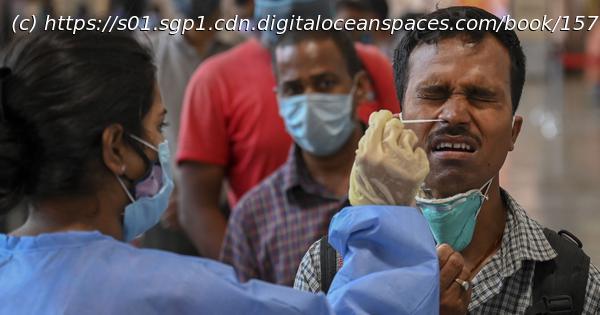Public health specialist Dileep Mavalankar and infectious diseases consultant Sanket Mankad talk about the course of the pandemic’s second wave in India.
India is now seeing over 2,00,000 new Covid-19 cases a day and states across the country are witnessing record highs. In some states like Gujarat, which saw a new high of over 7,400 cases on April 15, there are reports of a mismatch between the government’s figures of Covid-19 deaths, particularly in big cities like Ahmedabad, Rajkot and Surat and other sources. This seems to be happening in other states as well. What is happening in Gujarat? Is it simply that the number of deaths is not adding up vis-à-vis other parts of the country, or is Gujarat’s situation symptomatic of a larger reality that more Indians are succumbing to Covid-19 now compared to the first wave? And is this due to Covid-19 mutations and variants, or something else? What could be India’s way out of this second wave? What vaccination strategies should India pursue? We ask Dileep Mavalankar, director of the Indian Institute of Public Health, Gandhinagar and Sanket Mankad, an infectious diseases consultant who sounded a warning back in November 2020 that we should focus on an imminent second wave, for the view from Ahmedabad. Excerpts from the interview: Dr Mavalankar, when we last spoke in August 2020, you had done a study looking at the prevalence of Covid-19 within families. One of your key findings was that the disease was not spreading as intensely within families as it was outside and in 70%-80% of cases, family members of Covid-19 persons were not affected. Was that because of the behaviour of the virus at that time? How have things changed in this second wave? Dileep Mavalankar: The first major change we see in this second wave, at least anecdotally, is that entire families are affected, save maybe one person. We are planning to do a similar study again now, and have asked for government permission to access the data. The second major change is the rapid increase in cases. The first wave started in March2020-April 2020 and peaked half a year later in September 2020, whereas this second wave has started in mid-February, has rapidly surpassed last year’s wave by a margin of two and has not yet peaked. The third major change is that more younger people are getting infected in this wave than in the first. Earlier it seemed there was low mortality in the second wave, but now it seems that mortality is catching up and is also rapidly increasing. Fourth, again anecdotally, rural areas are also seeing quite a few cases, unlike in the first wave, despite there being less testing in rural areas compared to big cities. Dr Mankad, tell us what changes you are seeing while treating patients at the front line. Sanket Mankad: The major change we are observing currently as clinicians and infectious disease specialists is that the virulence of the virus is a bit higher compared to what we saw last April, May, October and November. As Dr Mavalankar rightly said, currently we find entire families to be positive. Second, young adults are also being infected, who earlier were relatively safer. Third, the virulence of the virus in younger adults is also currently high and it is worrying that younger adults are developing pneumonia faster. One more thing is the altered coagulability of blood secondary to Covid-19 infection is also notable in this particular subset of patients. The acute respiratory distress syndrome, ie the development of lung infiltrates in both lungs is also increasing in young adults. That is a point to ponder about in this second wave. Currently, the second wave that we are seeing is by and large restricted to the four major cities of Gujarat – Ahmedabad, Rajkot, Vadodara and Surat. But, as Dr Mavalankar said, the urban peripheries are also not being spared in this second wave. One more notable thing about this second wave is the unusual presentation of cases. Patients are presenting with acute diarrhoea, dehydration and multi-organ involvement. In the earlier phases, we were not seeing children getting infected, but now young mothers between 35-year and 45-year-old are getting infected and subsequent transmission to children is also being increasingly seen. In children, we find multi-system inflammatory syndromes. These are the differences in the clinical presentation of the patient profile that we clinicians are seeing. On TV, we have been seeing ambulances with sick persons lined up outside hospitals in Gujarat and also ambulances with persons awaiting cremation. Why is there such a surge? Is it due to people not getting tested and therefore not getting treatment in time? Sanket Mankad: In January and February, there was a drastic fall in the number of active Covid-19 cases, which was widely documented. Therefore, one year and a quarter into the pandemic, pandemic fatigue set in. We human beings are social animals. So when people found that cases are low, weddings, get-togethers and all sorts of gatherings did occur during that period of time. One thing we definitely forgot was the importance of SMS – social distancing, masks and sanitisation. Vaccination was introduced, which might have given a false sense of security to a certain group of people who received the vaccine. These all are the factors that contributed to indifference towards the development of the second wave, which was definitely an impending second wave. You talked about blood conditions as well as lung conditions in younger people. Are these more prevalent in younger people now and not seen in older people, including during the first wave? Sanket Mankad: No, we definitely see senior citizens, diabetics, hypertensive patients with coronary artery disease, who are prone to develop bilateral pneumonia and acute respiratory distress syndrome. They are definitely presenting with these things. But earlier during the first wave, the younger adults were not so highly susceptible. The clinical implication is that the virulence of Covid-19 might have increased. One more thing we need to think about is that the sequencing of this particular virus also needs to be done, to find out whether it has changed its genetic structure, has undergone any mutation, or has acquired new virulence factors (invading the hosts’ immune systems) and thereby enhancing the attachment of the virus to the respiratory epithelium.
Home
United States
USA — Science Interview: India is undercounting Covid-19 numbers and deaths by not including suspected...






